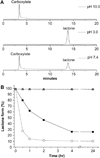Poly(omega-pentadecalactone-co-butylene-co-succinate) nanoparticles as biodegradable carriers for camptothecin delivery
- PMID: 19632718
- PMCID: PMC2774808
- DOI: 10.1016/j.biomaterials.2009.06.061
Poly(omega-pentadecalactone-co-butylene-co-succinate) nanoparticles as biodegradable carriers for camptothecin delivery
Abstract
In this study, we show that degradable particles of a hydrophobic polymer can effectively deliver drugs to tumors after i.v. administration. Free-standing nanoparticles with diameters of 100-300 nm were successfully fabricated from highly hydrophobic, biodegradable poly(omega-pentadecalactone-co-butylene-co-succinate) (PPBS) copolyesters. PPBS copolymers with various compositions (20-80 mol% PDL unit contents) were synthesized via copolymerization of omega-pentadecalactone (PDL), diethyl succinate (DES), and 1,4-butanediol (BD) using Candida antarctica lipase B (CALB) as the catalyst. Camptothecin (CPT, 12-22%) was loaded into PPBS nanoparticles with high encapsulation efficiency (up to 96%) using a modified oil-in-water single emulsion technique. The CPT-loaded nanoparticles had a zeta potential of about -10 mV. PPBS particles were non-toxic in cell culture. Upon encapsulation, the active lactone form of CPT was remarkably stabilized and no lactone-to-carboxylate structural conversion was observed for CPT-loaded PPBS nanoparticles incubated in both phosphate-buffered saline (PBS, pH=7.4) and DMEM medium for at least 24 h. In PBS at 37 degrees C, CPT-loaded PPBS nanoparticles showed a low burst CPT release (20-30%) within the first 24 h followed by a sustained, essentially complete, release of the remaining drug over the subsequent 40 days. Compared to free CPT, CPT-loaded PPBS nanoparticles showed a significant enhancement of cellular uptake, higher cytotoxicity against Lewis lung carcinoma and 9L cell lines in vitro, a longer circulation time, and substantially better antitumor efficacy in vivo. These results demonstrate the potential of PPBS nanoparticles as long-term stable and effective drug delivery systems in cancer therapy.
Figures













Similar articles
-
Amphiphilic block co-polyesters bearing pendant cyclic ketal groups as nanocarriers for controlled release of camptothecin.J Biomater Sci Polym Ed. 2011;22(10):1275-98. doi: 10.1163/092050610X504260. J Biomater Sci Polym Ed. 2011. PMID: 20594408 Free PMC article.
-
Lipase-catalyzed copolymerization of dialkyl carbonate with 1,4-butanediol and ω-pentadecalactone: synthesis of poly(ω-pentadecalactone-co-butylene-co-carbonate).Biomacromolecules. 2011 May 9;12(5):1912-9. doi: 10.1021/bm2002522. Epub 2011 Apr 18. Biomacromolecules. 2011. PMID: 21449602
-
Biodegradation, biocompatibility, and drug delivery in poly(ω-pentadecalactone-co-p-dioxanone) copolyesters.Biomaterials. 2011 Sep;32(27):6646-54. doi: 10.1016/j.biomaterials.2011.05.046. Biomaterials. 2011. PMID: 21641030 Free PMC article.
-
Improved tumor targeting and antitumor activity of camptothecin loaded solid lipid nanoparticles by preinjection of blank solid lipid nanoparticles.Biomed Pharmacother. 2016 May;80:162-172. doi: 10.1016/j.biopha.2016.03.018. Epub 2016 Mar 26. Biomed Pharmacother. 2016. PMID: 27133053
-
Antitumoral activity of camptothecin-loaded nanoparticles in 9L rat glioma model.Int J Pharm. 2011 Jan 17;403(1-2):201-6. doi: 10.1016/j.ijpharm.2010.10.015. Epub 2010 Oct 15. Int J Pharm. 2011. PMID: 20951783
Cited by
-
Glycoprotein CD98 as a receptor for colitis-targeted delivery of nanoparticle.J Mater Chem B. 2014 Mar 21;2(11):1499-1508. doi: 10.1039/C3TB21564D. J Mater Chem B. 2014. PMID: 24729869 Free PMC article.
-
Synthetic high-density lipoproteins for delivery of 10-hydroxycamptothecin.Int J Nanomedicine. 2016 Nov 22;11:6229-6238. doi: 10.2147/IJN.S112835. eCollection 2016. Int J Nanomedicine. 2016. PMID: 27920529 Free PMC article.
-
Poly(lactide-co-glycolide) nanoparticle assembly for highly efficient delivery of potent therapeutic agents from medical devices.Biomaterials. 2010 May;31(13):3631-42. doi: 10.1016/j.biomaterials.2010.01.048. Epub 2010 Feb 10. Biomaterials. 2010. PMID: 20149428 Free PMC article.
-
A lupus anti-DNA autoantibody mediates autocatalytic, targeted delivery of nanoparticles to tumors.Oncotarget. 2016 Sep 13;7(37):59965-59975. doi: 10.18632/oncotarget.11015. Oncotarget. 2016. PMID: 27494868 Free PMC article.
-
Amphiphilic block co-polyesters bearing pendant cyclic ketal groups as nanocarriers for controlled release of camptothecin.J Biomater Sci Polym Ed. 2011;22(10):1275-98. doi: 10.1163/092050610X504260. J Biomater Sci Polym Ed. 2011. PMID: 20594408 Free PMC article.
References
-
- Feng SS. Nonoparticles of biodegradable polymers for new-concept chemotherapy. Expert Review of Medical Devices. 2004;1:115–125. - PubMed
-
- Peer D, Karp JM, Hong S, et al. Nanocarriers as an emerging platform for cancer therapy. Nature Nanotechnology. 2007;2:751–760. - PubMed
-
- Min KH, Park K, Kim YS, et al. Hydrophobically modified glycol chitosan nanoparticles-encapsulated camptothecin enhance the drug stability and tumor targeting in cancer therapy. Journal of Controlled Release. 2008;127:208–218. - PubMed
-
- Maeda H. The enhanced permeability and retention (EPR) effect in tumor vasculature: The key role of tumor-selective macromolecular drug targeting. Advances in Enzyme Regulation. 2001;41:189–207. - PubMed
-
- Maeda H, Bharate GY, Daruwalla J. Polymeric drugs for efficient tumor-targeted drug delivery based on EPR-effect. European Journal of Pharmaceutics and Biopharmaceutics. 2009;71:409–419. - PubMed
Publication types
MeSH terms
Substances
Grants and funding
LinkOut - more resources
Full Text Sources
Other Literature Sources
Medical

